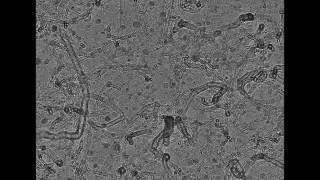Nanotube growth moving in the right direction
 (Download Image)
This transmission electron microscope image shows growth of a dense carbon nanotube population.
(Download Image)
This transmission electron microscope image shows growth of a dense carbon nanotube population.
For the first time, Lawrence Livermore National Laboratory scientists and collaborators have captured a movie of how large populations of carbon nanotubes grow and align themselves.
Understanding how carbon nanotubes (CNT) nucleate, grow and self-organize to form macroscale materials is critical for application-oriented design of next-generation supercapacitors, electronic interconnects, separation membranes and advanced yarns and fabrics.
New research by LLNL scientist Eric Meshot and colleagues from Brookhaven National Laboratory (BNL) and Massachusetts Institute of Technology (MIT) has demonstrated direct visualization of collective nucleation and self-organization of aligned carbon nanotube films inside of an environmental transmission electron microscope (ETEM).
In a pair of studies reported in recent issues of Chemistry of Materials and ACS Nano, the researchers leveraged a state-of-the-art kilohertz camera in an aberration-correction ETEM at BNL to capture the inherently rapid processes that govern the growth of these exciting nanostructures.
Among other phenomena discovered, the researchers are the first to provide direct proof of how mechanical competition among neighboring carbon nanotubes can simultaneously promote self-alignment while also frustrating and limiting growth.
"This knowledge may enable new pathways toward mitigating self-termination and promoting growth of ultra-dense and aligned carbon nanotube materials, which would directly impact several application spaces, some of which are being pursued here at the Laboratory," Meshot said.
Meshot has led the CNT synthesis development at LLNL for several projects, including those supported by the Laboratory Directed Research and Development (LDRD) program and the Defense Threat Reduction Agency (DTRA) that use CNTs as fluidic nanochannels for applications ranging from single-molecule detection to macroscale membranes for breathable and protective garments.
Contact
 Anne M. Stark
Anne M. Stark
[email protected]
(925) 422-9799
Related Links
VideoChemistry of Materials
ACS Nano
LLNLBiosecurity and Bionanoscience Group
‘Second skin’ uniform protects soldiers from biological and chemical agents in the field"
Tags
Advanced Materials and ManufacturingCarbon nanotubes
Physical and Life Sciences
Featured Articles








